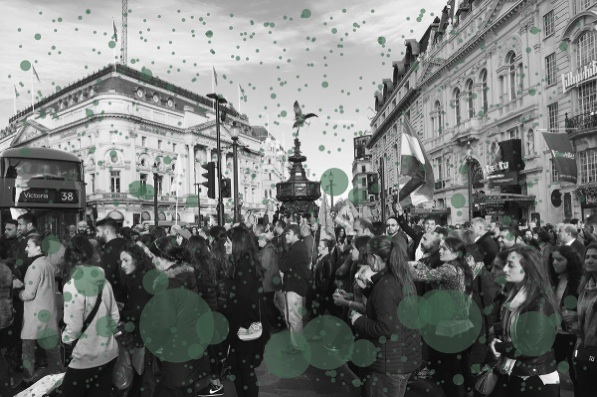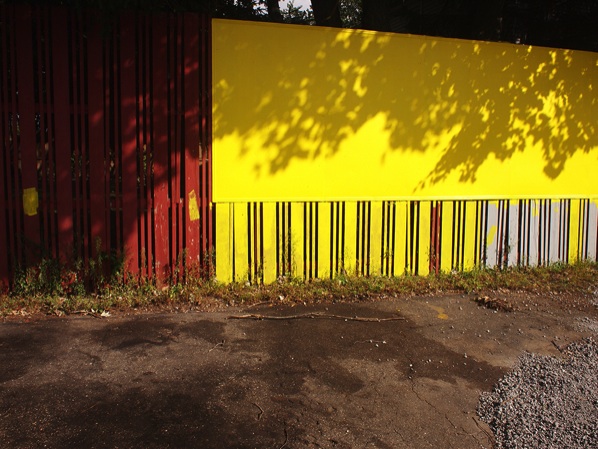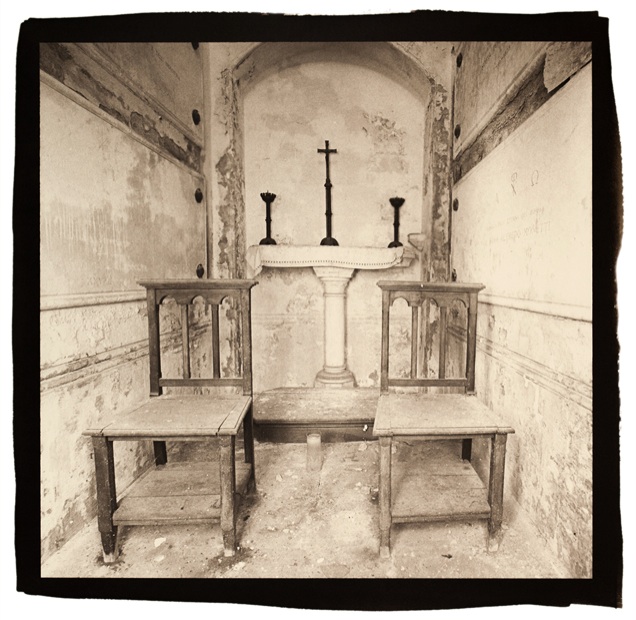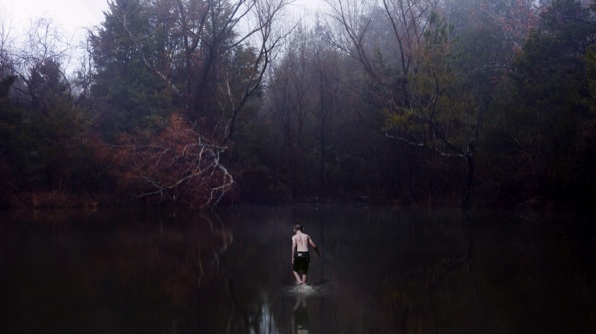Adriane Little
"Mapping Mrs. Dalloway"
Literature is riddled with dead or otherwise missing mothers. Virginia Woolf's life and writing were partly, yet significantly guided by the death of her mother when Woolf was just 13 years old. This loss reappears across her novels. As an artist, Adrianne Little is interested in studying both Woolf's writing and her as a woman who experienced this early and profound loss. Conceptually, this work is supported by continued research to advance the trope of the missing mother. "Mapping Mrs. Dalloway" represents a new way of visualizing text and image within Little's practice by incorporating data-mapping this new work.
For "Mapping Mrs. Dalloway", Little walked the streets of London and photographed along the path that Mrs. Dalloway walks in the novel. In doing so, Little brought the walking path and Mrs. Dalloway forward 90 years into the present. These are the same streets that Woolf herself walked countless times. Little's intension was not to illustrate the novel, but instead to use stream of consciousness in capturing the images. This mirrors the literary strategy of the novel. This project challenged Little to photograph in a new way. She was limited to a specific amount of time while in England. She knew where she could walk but she was not certain what she would actually find. As each day past, she became more familiar with the sense of place created by the movement of people in the city and the project evolved.
After returning from England, she divided the text of the novel into 20 sections. Each section is then visualized as a word count of the novel and layered over an image in the series. The circles grow larger the more often a particular word was repeated. The green that is used for the data-mapping was color matched from photographs she took of the wall paint while inside of Monk's House. The data visualization both obscures and reveals information within each image. She perceives the interaction of the mapping within each image as moments of loss.
Adriane Little is a conceptual artist and educator living in Kalamazoo Michigan. Her studio proctice originates from the perspective of photographic processes, but also crosses media and theoretical positions. The underpinnings of her visual work and research are at an intersection of trauma and ritual through an interrogation of a presence and absence of the maternal body. The translation of this space is both literal and metaphor or the architecture of an ephemeral meternal space that is embedded within what she calls the matrilinial ghost. As a continuation of these ideas, recent work turns to literature as a source of viusalization. Leterature is reiddled with dead or otherwise missing mothers.
By both committee and invitation, her artwork has received national and international recognitition in numerous exhibitions and video screenings. Since arriving to Western Michigan University in fall 2006, her artwork has exhibited in 57 different venues in 52 international cities and in 88 different venues in 70 U.S. cities. Most notable and recent venues include; Gallery 1301 (Philadelphia, PA), CEPA Gallery (Buffalo, NY), The Institute of Culture (Trboblje, Slovenia), The Center for Photography at Woodstock (Woodstock, NY), Albright-Knox Art Gallery (Buffalo, NY), Chelsea Art Museum (New York City, NY), Syracuse International Film Festival, Siouxland Film Festival, Milwaukee Short Film Festival, Dawson City International Film Fesival in the Yukon, Macon Film and Video Festival, Three Rivers Film Festival and the Leeds International Film Festival in the U.K., among others. She has curated several exhibitions including "Plus 3 Ferris Wheels", "17 Days" and several solo exhibitions in galleries and online.



MARCH - SEPTEMBER, 2019
This new feature will provide the opportunity for photographers to showcase a portfolio of your photographic work prominently in our front gallery flat files. The portfolios are available for patrons of the gallery to view, learn about the photographers and their work, and purchase photographs. Each portfolio consists of 12 - 20 prints in a flat file labeled with the photographers name.
FLAT FILE FEATURE - SPRING 2019
FEATURED ARTISTS: Ruth Adams, Lexington, KY; Adam Bernard, Medina, OH; Dominic Lippillo, Starkville, MS; Adriane Little, Kalamozoo, MI; and Edward Webb, Pecos, NM.
Ruth Adams
"Conversations with the Ancestors"
A cemetery is thought of as a place for memorializing a loved one, a place to say goodbye, a place for reflection on one's own mortality. More interestingly, cemeteries are a place to have a conversation with an ancestor, a place to ask for advice or work out a problem. These images invite communication, intervention, questions and connection. They remind us to take guidance from the wisdom and the energy of the ages.
During Adams' time in Italy and Germany she became ever increasingly aware of the importance these countries place on the wisdom of those that came before. In Berlin, for example, the acknowledgment of the realities of WWII is genuine, raw and ever present. For her, someone of Jewish heritage, the visit to Berlin was intense and life changing. All over Berlin the phrase used isn't what I grew up with in America: "6 million Jews were Killed in the holocaust", the phrase is "6 million Jews were Murdered in the holocaust". This simple turn of phrase changed my entire understanding of ownership of ones past. The Germans aren't using euphemisms for what happened, they are acknowledging the deeds of their ancestors and learning from them. The experience she had in Italy was different but also powerful. While visiting cemeteries in Tuscany she began to notice that in the crypts there were often chairs set up in pairs; symbolizing, or maybe actually allowing for, conversation. The implication seemed to be, come in, sit down, and let us share with you our wisdom. In times of such upheaval in the U.S., the profound connection that these two conuntries have to their history, and the invitation to learn from it gives me hope that we too can learn from our past mistakes.
For as we know "Those who cannot remember the past are condemned to repeat it" - George Santayana
"Conversations with the Anscestors" was inspired by these two experiences and the imagery suggests connections to the past.
Ruth Adams is a nationally recognized artist and an Associate Professor of Art at the University of Kentucky. Adams' photography deals with issues of mindfulness, intimacy, ancestry, mortality and renewal. She has exhibited internationally, won numerous awards and grants, and her photographs hang in numerous private and public collections. Adams holds an MFA in Photography and digital Art from the University of Miami, a BFA in Photography from Rochester Insitute of Technology, and a BS in Computer Science from Syracuse University. An experienced photographer, digital/analog hybrid artist, and educator, Adams has developed a reputation as a dynamic instructor and an innovative artist, and has enjoyed introducing students to the ever changing world of analog and digital photography.
Edward Webb
Here's a set of loose pages blowing back and forth in the wind like an open book.
Born in 1963 in Colorado, joined U.S. Army in 1983, stationed in Berlin '84-'87, residing in Berlin '84-'99, Photo Instructor '87-'92, Associates/Photography/Central Texas College, Europe '87-'89, Bachelors/Art History/University of Maryland, Europe '89-'92, exhibited in Berlin '90-'99, moved back to U.S. 1999, residing since in New Mexico.
Adam Bernard
"Project Belvedere"
Bernard is a Generation X-er native to Akron in "The Rustbelt" region of Northeast Ohio. "The Rustbelt", while it isn't paradise, is home to him. He has experienced and understood the process of postindustrial decline and renewal of this region during the latter stage of the 20th century. The transformational effects of capitalism and social values do not happen here at a rapid pace, they move slowly if they move at all. This region is constantly playing catch up with other areas and similar markets of the United States. Even though revitalization occurs here, there is still an abundance of entities from the past centuries that still endure today. Throughout their lifespan all entities evolve from their original physical state of materialization until their demise. That is reality. That is the circle of life. Beauty is here. Beauty is everywhere.
All beings face extremes and strive to endure because the will to live is basic and universal. Humans are blessed with the ability to find clarity at different stages of their lives. In Fydor Dosoevesky's philosophical novel "The Idiot" it was proclaimed by the main character, Prince Myskin, "beauty will save the world". This simplistic phrase is considered a prophecy by some. Hearing these words gave Bernard a moment of clarity and optimism. Why can't beauty save the world? Doesn't beauty already incrementally make the world a better place? If the world will be saved by beauty then the world will be sustained by love because beauty is love and love is beauty. He has devoted his artistic abilities to the creation of beautiful photographs as works of art in order to help save the world.
Each entity rides a different wave of existence here on Earth. It is his belief that natural and man-made entities, in all of their manifestations, are formed by their creator awith an intended purpose for their lifetime. His endeavor, entitled "Project Belvedere". (Belvedere: Italian for beautiful view) is his ongoing photographic mission that has the sole objective of capturing elements of beauty about the wide-ranging entities that are present among the land and scenery within the urban, suburban and rural areas of the ordinary world. "Project Belvedere" allows him to share this beauty that he has recorded as a photograph.
Out of reverence for the documentary and street photographers of the 20th century, he treats his digital camera as if it were loaded with a roll of old fashioned Kodachrome 35mm slide film. He capures beauty by composing his photographs using the available elements of our planet; illumination, space, time, surface and color.
"I realize there is so much beauty to photograph and too little time. I am not waiting for a renaissance to begin. Beauty is here now. I am photographing it. I am creating beauty, to help save the world".
- Adam Bernard, "The Ranger"
Adam Bernard, "The Ranger", is a photographer of the land, scenery and human spirit. In Bernard's photography you will witness brilliant images as seen from his eyes to the light that is drawn on paper.
Adam Bernard is based in Medina, Ohio. Bernard earned his BFA from the University of Akron and is an alumnus of St. Vincent-St. Mary H.S. in Akron, Ohio. He was awarded two individual Artist Felloships by the Ohio Arts Council; 1995 and 1997. Professionally, he worked as a news photographer for nearly a decade at Sun Newspapers, Cleveland, Ohio, and the Beacon Journal, Akron, Ohio and taught photogrpahy at the University of Akron. Bernard participated in the Midwest Photographers Project at the Museum of Contemporary Phorography, Chicago, IL. In 2016, Photographer Larry Fink awarded Bernard "Runner-up Best of Show" at the Photo Midwest Festival Exhibition at the Overture Center for the Arts in Madison, WI.

Dominic Lippillo
"Stories We Tell Ourselves"
During Lippillo's childhood he lived in fifteen different houses in the Midwest - a part of the country that feels as placeless as the rental houses his family occupied. As a result, he has always felt like an outsider abserving and wondering about the area he was inhabiting. Each time they moved he bacame fascinated and haunted by the residual essence of the former inhabitants that still lingered in and around the home. Throughout the series, "Stories We Tell Ourselves", memory, landscape, and vernacular images, coalesce in a series of constructed photographs. Drawing influence from his experiences, American Scene painting, literature, and cinema; Lippillo seeks out non-specific American landscapes to become settings that simultaneously feel familiar and unfamiliar. In doing so, he embellishes the images by adding atmospheric conditions and appropriated figures that are alien to the melancholic landscapes.
He begun the process for this series by photographing unoccupied suburban and rural areas to serve as backdrops of the everyday. He then searches through his collection of anonymous vernacular images - photographs with unknown internal and external contexts - that have been purchased in secondhand shops to find figures to inhabit the minimalistic scenes. In doing so, a pensive human presence appears as an ruckenfiur contemplating the landscape for the viewer to identify with, or as a visual device to direct the viewer's gaze around the frame. He approaches finding the locations to photograph, and chooses the figures to appropriate, with an eye for ambiguity and an irrational attraction and fascination to unassuming details, thus allowing his mind to wander outside of the confines of his eye's visual field.
In these re-contextualized photographic realities, the landscapes and figures share a symbiotic relationship, which allows them to transcend time, space, and experience due to their juxtaposition. By creating composite photographs, he is inviting the viewer to impose new meanings and create their own re-telling's of the stories intertwining the anonymous figures and unspecified locations.
During his childhood Dominic Lippillo's family rented a considerable number of houses. Every time they moved to a new house he would wonder about the uncountable past experiences that may be embedded within the walls, how the former inhabitants used the space, and how their time in this space affected their lives. As a result, he became fascinated by the residual essence of the former inhabitants that still lingered and the remnants they unintentionally left behind that seemed discarded, forgotten, or unwanted.
Throughout his projects Lippillo often photographs in or around his personal surroundings in an attempt to understand the spaces and the people who once lived there. In doing so, he created photographs of experiences that exist in his mind but not in reality. He aims to create and capture fictitious moments, while subsequently calling into question the legitimacy of photographic representation by employing a practice, which utilizes staged photography, found vernacular photographs, and digital composite imagery in which he embellishes the depicted information through a process of addition and deletion.
Selections of his collaborative work are included in the permanent collections of The Museum of Photographic Art; The Museum of Fine Arts, Houston; The University of Alabama, Tuscaloosa; and The University of North Dakota. Features in publications include "Some Recent Findings", "Don't Take Pictures", "Momo Chroma", "Exposure", "Daily Serving", "The Eye of Photography", and the "INPHA Annuals II and IV". Grants and Awards include: South Arts Fellowship (2018), Finalist Critical Mass Top 200 (2017 & 2016), Mississippi Arts Commission Visual Artist Fellowship (2016), several Mississippi Arts Commission Artist Mini-Grants (2010, 2013, 2014, and 2018), and the Mississippi State University Faculty Research Award for the College of Architecture, Art and Design (2013). Lippillo earned his MFA in Photography from Ohio University (2009) and a BFA in Photography from Youngstown State University (2005), and is an Associate Professor of Photography at Mississippi State University.
